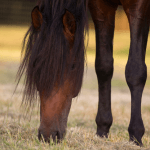Strip-Grazing: No Increase in Physical Activity Among Horses

Strip-grazing provides a myriad of benefits to horses and their owners. This particular grazing system serves as a management tool for weight control or laminitis deterrence, a way to foster pasture growth and recovery, and an acclimation area for horses unfamiliar with grazing.
Despite these benefits, researchers in the United Kingdom wondered whether the reduced paddock size usually seen in strip-grazing systems hinders physical activity. They aimed to find out by observing behavior of horses in traditional and strip-grazed paddocks, and measuring movement through the use of accelerometers.
This research was divided into two separate studies. In the first study, 10 ponies were assigned to one of two paddocks. Though the paddocks were the same size, one was divided into seven uniform areas for strip-grazing. The same forage, both quality and quantity, was available in the two paddocks. The ponies grazed for seven days. In the second study, which lasted for 14 days, 10 different ponies were split between (1) a control field where ponies were allowed complete access to the entire paddock, (2) a field that increased in size daily by moving one fenceline, or (3) a field that was strip grazed with lead and back fences moved the same distance daily.
Accelerometer data were organized in 24-hour periods, with each 10-second fragment placed in one of three categories: standing, grazing, or moving. Time spent in each category was then calculated for each horse. Direct observation was used to note behavior for three days of the second study. Researchers compared accelerometer and behavioral data for both studies.
In the end, researchers found that strip-grazing had no effect on the amount of activity by ponies in either study; ponies moved the same amount whether they were in open or strip paddocks. Regardless of paddock, ponies spent the same amount of time grazing. As expected, strip-grazed ponies preferentially grazed areas that were new to them once fences were moved.
As aforementioned, strip-grazing is an effective method to limit forage intake. But dietary requirements don’t end with fresh forage, no matter its quality, according to nutritionist Kathleen Crandell, Ph.D., of Kentucky Equine Research. Horses on all-forage diets require additional fortification in the form of a ration balancer or a high-quality vitamin and mineral supplement.
When soundness allows, easy keepers should be exercised to help prevent unwanted weight gain, with the goal of maintaining horses and ponies in moderate body weight. The importance of exercise cannot be downplayed when managing overweight horses. Long-term obesity may predispose these horses to metabolic disorders, and exercise is thought to delay the onset of disease or mitigate clinical signs associated with the disease.
In times of the year when fresh forage is not available, additional vitamin E may be necessary, as preserved forages such as hay become depleted of it quickly after curing. Choose a natural-source, nanodispersed vitamin E, such as Nano-E, for optimal absorption.
*Cameron, A., A. Longland, T. Pfau, S. Pinnegar, I. Brackston, J. Hockenhull, P.A. Harris, N.J. Menzies-Gow. 2022. The effect of strip grazing on physical activity and behavior in ponies. Journal of Equine Veterinary Science 110:103745.








